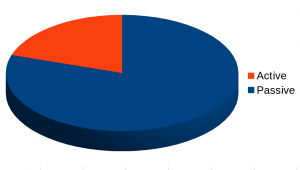
If you listen a lot, most of it will have to be passive listening. The proportions here are somewhat arbitrary, but passive listening will take up much more time than active listening.
In a previous article, I discussed three steps to more and better Chinese listening practice. In short, you need to find interesting audio you can understand, you need to make it easily available and, finally, you need to find a way of maintaining your listening habits for a long time. That last step merits a more detailed discussion!
Improving listening ability in the long run
I have learnt Chinese for seven years now, and I know how hard it is to keep up listening practice while being busy with other things. I mentioned the key to success in last week’s article, but there simply wasn’t room to explain it properly. This is what I wrote:
It’s very hard to listen to difficult audio for longer than ten minutes. If I listen to something where I have to really, really concentrate to understand what’s going on, I start feeling tired quickly. It’s simply not possible to force yourself to take in difficult audio for hours on end. Instead, you should strive to find audio on different levels. Some audio you can listen to when your energy levels are high, other sources are more suitable for when you feel tired.
Listening a lot is difficult, not because it’s hard to listen in itself, but because it’s not easy to find the amount of listening material you need and manage it properly. You should find audio that is comprehensible, but as we all know, what is comprehensible varies.
If I’m well rested, I can understand more difficult audio than when I’m tired. If I listen actively I can understand more difficult audio than when I’m doing something else at the same time.
Therefore, you not only need audio suitable to your level in general, you need to be able to adjust the audio to the current situation. This is related to what I have written about studying according to your current productivity level.
I sort my audio into two categories, let’s call them “hard” and “easy”. I recommend that you create actual folders on your computer and/or phone. Feel free to use more than two categories if you want, but I’ll keep it simple here.
Category #1: Hard
Audio in this category is for active listening. It’s audio you need to focus on seriously to understand. If you listen more than ten or twenty minutes, you start feeling tired. Because of this, the bulk of the audio you listen to and therefore the audio you need to have available is not going to be in this category.
I currently listen to 白鹿原 by 陈忠实 and it falls firmly in this category for me. I find this audio book very hard to follow and I need to focus 100%, otherwise my thoughts start flying all over the place and I lose track of the story. I typically listen 10-20 minutes each time, usually when talking a walk. I can’t do anything more complicated at the same time, I need all my concentration on the audio.
Naturally, what you think is hard depends on your proficiency level. Beginners will find it hard to listen to new chapters in their textbook, intermediate learners will struggle with learner podcasts mainly in Chinese. Advanced learners will struggle with anything they aren’t used to already.
If you don’t understand much even when you concentrate 100%, you should put the audio in a third folder called “too hard” and leave it there until your listening ability has improved.
Category #2: Easy
The audio in the “easy” category is for passive listening. It needn’t be extremely easy, but it should be the kind of audio you can keep up with for extended periods of time, preferably even while engaged in other tasks at the same time (nothing too complex, I mean things like cooking, driving or doing the laundry). Since you can listen for long periods of time in many situations, you need much, much more audio in this category. The more the better.
I put two types of audio in the “easy” category:
- Audio I have already listened to before and found interesting
- New audio I can understand without concentrating too much
For the purpose of the listening challenge, I use the advanced lessons from ChinesePod and a few radio programs I’ve already listened to. Since boredom is a real problem here, focus on audio you find interesting.
If you’re a beginner, it will be very hard to find audio to put in this category, it will have to be things you have already listened to.
For intermediate learners, everything you have listened to already plus intermediate podcasts will work. For advanced learners, things are as usual much easier.
Moving audio from “hard” to “easy”
Part of the reason I use a system like this is that it’s easy to move audio around. If you have studied something in the “hard” category for some time, it won’t be feel difficult anymore.
What most students do then is to forget about it and move on to the next challenge. Don’t do that. Instead, keep the audio, but move it to the “easy” category.
This is essential for beginners and intermediate learners since this will be your main source of easy audio. It also means you get to review what you have learnt. If the “easy” folder becomes too crowded, remove things you find boring, but I don’t think having too much content here is a problem.
Are you listening enough?
The more you listen, the better. The more diverse your listening is, the better. As I have discussed here and in previous articles, passive listening will have to make up most of your listening practice.
This isn’t because it’s better than active listening, it’s because it’s the only way you can listen enough while still living a normal life. Passive listening is for all that time when you can’t concentrate 100% on the audio. Make sure you have enough Chinese audio available!
